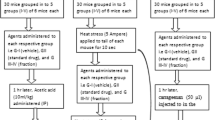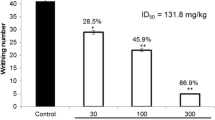Abstract
The effects of Curcuma mangga ethanolic extract (CME) and its fractions, e.g., aqueous, chloroform, ethyl acetate, and hexane fractions, from C. mangga rhizome were investigated on nociceptive responses using writhing, hot plate, and formalin tests in mice and inflammatory models using carrageenan-induced rat paw edema and croton oil-induced mouse ear edema. The results showed that CME and all fractions (200 mg/kg, p.o.) significantly reduced the number of writhings. Oral administration (p.o.) of CME, chloroform, and hexane fractions (200 mg/kg) significantly prolonged the latency time, whereas aqueous and ethyl acetate fractions were inactive. The activities of CME, chloroform, and hexane fractions were abolished by naloxone (2 mg/kg, intraperitoneal (i.p.)). CME and all fractions at the dose of 200 mg/kg significantly produced antinociception in both early and late phases of the formalin test. CME, chloroform, and hexane fractions were more prominent in licking inhibition than those of the aqueous and ethyl acetate fractions. CME and all fractions (150 mg/kg, p.o.) showed significant reduction of rat paw edema. The order of activity on inhibition of paw edema at 4 h was chloroform fraction > hexane fraction > ethyl acetate fraction > CME > aqueous fraction. When topically applied at 0.5 mg/ear, CME and all fractions suppressed ear edema induced by croton oil. CME and chloroform fraction showed a greater inhibition by 53.97 and 50.29%, respectively. These results suggested that CME and its fractions, especially chloroform and hexane fractions from C. mangga rhizome, possessed centrally acting analgesic as well as anti-inflammatory activities.
Similar content being viewed by others
References
Wong KC, Chong TC, Chee SG (1999) Essential oil of Curcuma mangga Val & Zijp rhizomes. J Essent Oil Res 11:349–351
Kirtikar KR, Basu BD, An ICS (1981) Indian medicinal plants, vol 4, 2nd edn. Taj Offset, New Delhi
Abas F, Lajis NH, Shaari K, Israf DA, Stanslas J, Yusuf UK, Raof SM (2005) Labdane diterpene glucoside from the rhizomes of Curcuma mangga. J Nat Prod 68:1090–1093
Kirana C, Record IR, McIntosh GH, Jones GP (2003) Screening for antitumor activity of 11 species of Indonesian Zingiberaceae using human MCF-7 and HT-29 cancer cells. Pharm Biol 41:271–276
Chaisawadi S, Keawboonruang S, Chantawong P (2006) Preliminary study on antibacterial activities of some medicinal herbs for Thai food usage. The 33rd Congress on Science and Technology of Thailand, Bangkok, Thailand, pp 1–3
Tewtrakul S, Subhadhirasakul S (2007) Anti-allergic activity of some selected plants in the Zingiberaceae family. J Ethnopharmacol 109:535–538
Evans WC (1989) Trease and Evans’ pharmacognosy, 13th edn. Bailliere Tindall, London
Koster R, Anderson M, Beer EJ (1959) Acetic acid for analgesic screening. Fed Proc 18:412
Woolfe G, MacDonald AD (1944) The evaluation of the analgesic action of pethidine hydrochloride (DEMEROL). J Pharmacol Exp Ther 80:300–307
Hunskaar S, Fasmer OB, Hole K (1985) Formalin test in mice, a useful technique for evaluating mild analgesics. J Neurosci Methods 4:69–76
Winter CA, Rusley EA, Nuss GW (1962) Carrageenan-induced edema in hind paw of the rat as an assay for anti-inflammatory drugs. Proc Soc Exp Biol Med 111:544–547
Tubaro A, Dri P, Delbello G, Zilli C, Logia RD (1985) The croton oil ear test revisited. Agents Actions 17:47–49
Collier HO, Dinneen LC, Johnson CA, Schneider C (1968) The abdominal constriction response and its suppression by analgesic drugs in the mouse. Br J Pharmacol 32:295–310
Derardt R, Jougney S, Benzoni J, Peterfalvi M (1980) Release of prostaglandins E and F in an algogenic reaction and its inhibition. Eur J Pharmacol 61:17–24
Wong CH, Day P, Yarmush J, Wu W, Zbuzek UK (1994) Nifedipine-induced analgesia after epidural injections in rats. Anesth Analg 79:303–306
Chapman CR, Casey KL, Dubner R, Foley KM, Gracely RH, Reading AE (1985) Pain measurement: an overview. Pain 22:1–31
Dhawan BN, Cesselin F, Raghubir R, Reisine T, Bradley PB, Protoghese PS, Haman M (1996) Classification of opioid receptors. Pharmacol Rev 48:567–592
Tjolsen A, Berge OG, Hunskaar S, Rosland JH, Hole K (1992) The formalin test: an evaluation of the method. Pain 51:5–17
Shibata M, Ohkubo T, Takahashi H, Inoki R (1989) Modified formalin test: characteristic biphasic pain response. Pain 38:347–352
Garcia LJ, Hamamura L, Leite MP, Silva R (1973) Pharmacological analysis of acute inflammatory process induced in the rat’s paw by local injection of carrageenan and by heating. Br J Pharmacol 48:88–96
Vineger R, Truax JF, Selph JH, Johnstone PR, Venable AL, McKenzie KK (1987) Pathway to carrageenan induced inflammation of the hind-limb of the rat. Fed Proc 6:118–126
Crunkhon P, Meacock SE (1971) Mediators of the inflammation induced in the rat paw by carrageenan. Br J Pharmacol 42:392–402
Tonelli G, Thibault L, Ringler I (1965) A bio-assay for the concomitant assessment of the antiphlogistic and thymolytic activities of topically applied corticoids. Endocrinology 77:625–634
Castagna M, Takai Y, Kaibuchi K, Sano K, Kikkawa U, Nishizuka Y (1982) Direct activation of calcium-activated, phospholipid-dependent protein kinase by tumor-promoting phorbol esters. J Biol Chem 257:7851–7947
Nakadate T (1989) The mechanism of skin tumor promotion caused by phorbol esters: possible involvement of arachidonic acid cascade/lipoxygenase, protein kinase C and calcium/cadmodulin systems. Jpn J Pharmacol 49:1–9
Sanchez T, Moreno JJ (1999) Role of leukocyte influx in tissue prostaglandin H synthase-2 overexpression induced by phorbol ester and arachidonic acid in skin. Biochem Pharmacol 58:877–879
Bos R, Windono T, Woerdenbag HJ, Boersma YL, Koulman A, Kayser O (2007) HPLC-photodiode array detection analysis of curcuminoids in Curcuma species indigenous to Indonesia. Phytochem Anal 18:118–122
Acknowledgments
The authors are very grateful to the Thailand Research Fund through the Royal Golden Jubilee Ph.D. Program (Grant No. PHD/0052/2549) for financial support of this research work.
Author information
Authors and Affiliations
Corresponding author
Rights and permissions
About this article
Cite this article
Ruangsang, P., Tewtrakul, S. & Reanmongkol, W. Evaluation of the analgesic and anti-inflammatory activities of Curcuma mangga Val and Zijp rhizomes. J Nat Med 64, 36–41 (2010). https://doi.org/10.1007/s11418-009-0365-1
Received:
Accepted:
Published:
Issue Date:
DOI: https://doi.org/10.1007/s11418-009-0365-1




